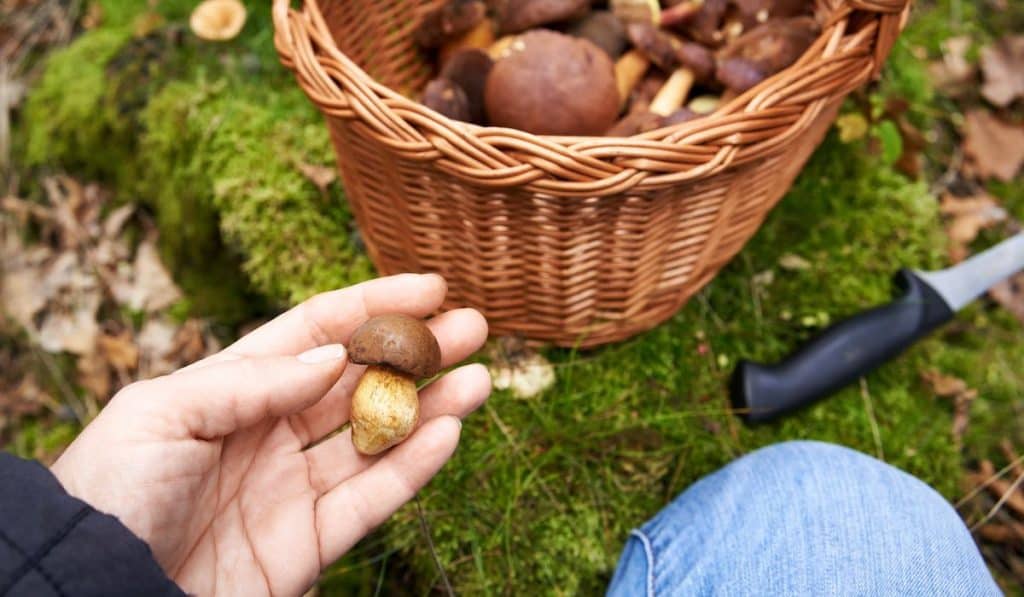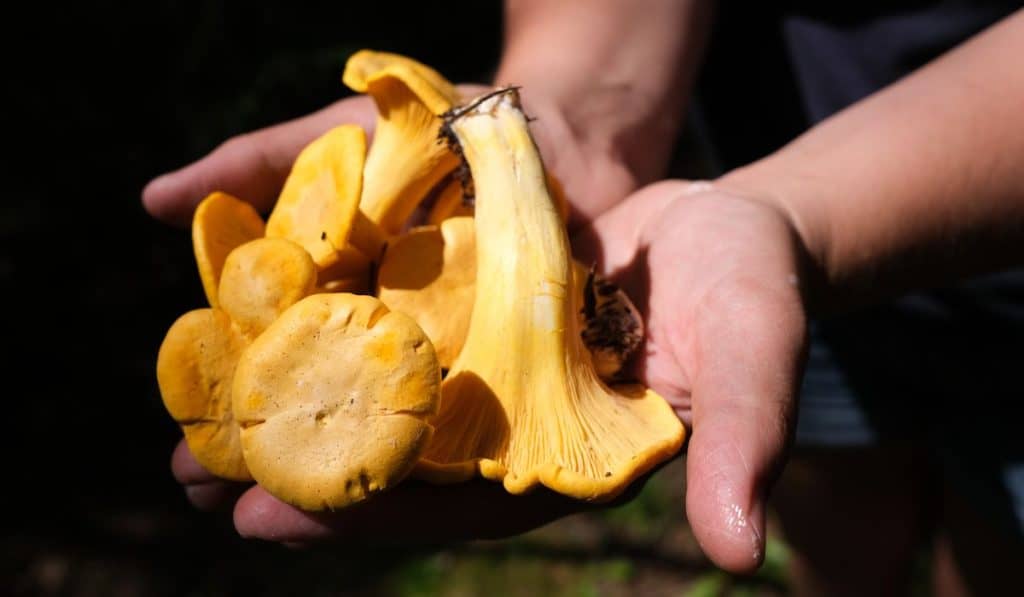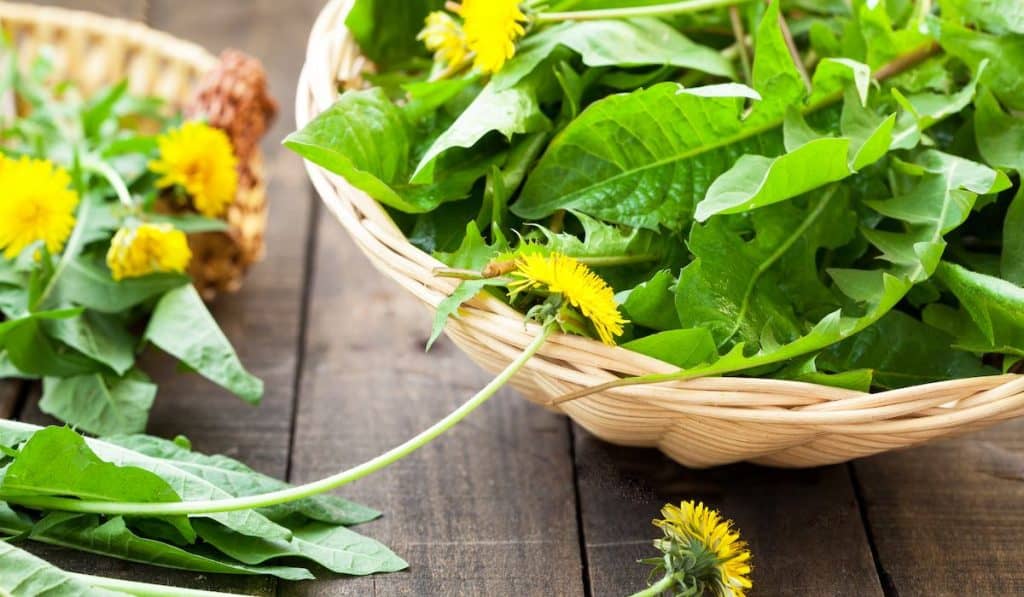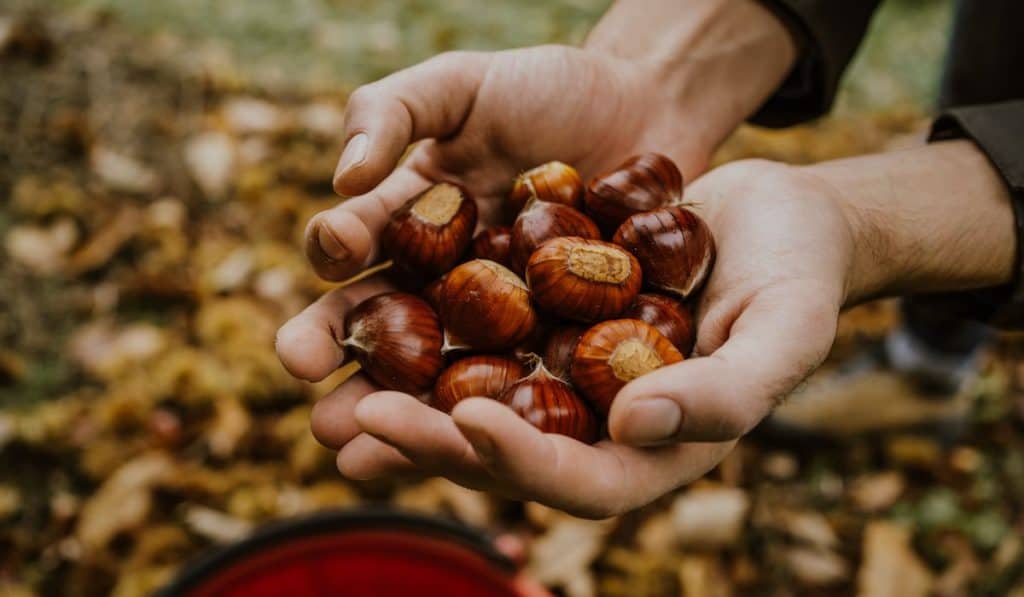Foraging is an outdoor activity that involves gathering wild berries, fruits, nuts, greens, roots, and mushrooms.
These can be made into a variety of lovely treats, snacks, and meals, like soups, salads, jams, pies, and more!
What is Foraging?
Simply put, foraging involves picking wild greens, herbs, roots, mushrooms, berries, and other natural edible foods. It’s an age-old activity that, during the beginnings of humanity, was a necessity (in some places, it still is).
Nowadays, with produce and plants readily available at the grocery store, foraging is considered to be more of a hobby!
The primary reason people forage is for the fun of it, and to imbue traditional foods with unique nutrients, texture, and flavor.

What Do You Need to Get Started Foraging?
Some Basic Know-How
The first and most important thing you will need before you start foraging is some basic know-how. This is 1) to preserve nature and 2) to protect yourself.
For example, you will need to be aware of how much is environmentally considerate to pick, and any poisonous plants to look out for.
Otherwise, you risk harming the land, depriving the wildlife, or ingesting something poisonous (some mushrooms and plants are even fatal).
It’s best to wait to move forward until you know how to be safe and respectful. These things are essential when it comes to becoming an expert forager.
Baskets
If you’re going foraging, you’ll need something to keep your fragile harvest in without crushing it. A basket or two will do the trick!
Protective Wear
In the great outdoors, ticks are almost always a danger. These are skin-burrowing, blood-drinking bugs that carry a variety of diseases, including Lyme disease (a very unpleasant and difficult to treat chronic illness).
Eliminate this risk by wearing bug spray, and donning long-sleeved shirts, long-sleeved pants, long socks, and other protective wear.
Gloves
Depending on what you’re foraging, you may find gloves useful. These will provide a defense against thorns while you forage for rosehips, prevent your hands from becoming stained by berry juice, etc.
Clippers
Picking without the use of a tool will increase the potential damage to the environment exponentially.
Invest in a nice, sharp pair of heavy-duty clippers. These will allow you to make clean, even cuts that will minimize damage and allow the plants to heal faster.
Drinking-Water
On any outdoor expedition, it’s important to bring plenty of water. Foraging is a light to moderate exercise, and you wouldn’t want to dehydrate or overexert yourself.
Pepper Spray
If you opt to forage in the forest, there is a slim but real chance you will meet a hungry bear. These will no doubt be looking for the same, ripe berries you are after. They tend to avoid civilization, however.
Just in case, many hikers and foragers recommend that you bring along some pepper spray, which can effectively deter a bear.
How Do You Forage?
So, how do you forage, exactly? First off, pick your location, like a nearby meadow or stretch of woodland.
Make sure that you are not intruding on private property or picking in a national forest that it’s not explicitly legal in. Also, consider the time of year. The prime times for foraging are the harvest months of fall and summer.
There are also a few early greens and flowers (such as dandelions) and cold-hardy roots in the spring and winter.
When Can You Find Some Common Foods to Forage?
Most foraging goods are available from late spring to late summer and early Autumn. Some, like violets, can even show up in the spring-winter.
| Feb | March | April | May | June | July | Aug | Sept | Oct | |
| Morrels | X | X | |||||||
| Chanterelles | X | X | X | ||||||
| Blackberries | X | X | X | ||||||
| Violets | X | X | X | X | X | ||||
| Redbuds | X | X | X | ||||||
| Ground Cherries | X | X | |||||||
| Stinging Nettle | X | X | X | X | X | X | |||
| Wood Sorrel | X | X | X | X | X | X |
Once you’ve chosen the perfect spot, gather your gear together, and head out the door!
Be Respectful
Remember, you’re not the only forager. In fact, most of the foragers are animals, which require sustenance for their survival.
This means that you should forage only when food is truly plentiful, and to take no more than ¼ of what grows in one area, so there’s plenty of food leftover.
Along with this, fill in holes that you dig roots from (to avoid exposing other roots or damaging the land in general).
Never pick endangered plants and try to focus on invasive species when you can (this way, you’ll actually be doing nature a favor).
Use only sanitized shears, to avoid exposing cut plants to diseases, pick at the base of the stem to avoid leaving behind damaged tissue, and keep your shears sharp, as this will help plants to heal and regrow faster.
Give Back to the Land
Nature is eternally generous, providing bountiful food and fresh air.
While you’re foraging, it’s good etiquette to show your appreciation of the land by cleaning up litter.
Where Should You Avoid Foraging?
There are some areas that you will probably not want to forage, such as the side of the highway, or next to a lake that’s known to be rather dirty.
What you forage will absorb these things (pollutants etc), and when you consume them, so will your body. Instead, look for spots that are pollution-free, like meadows, forests, etc.
Also, avoid pesticides, which are frequently used on residential lawns, parks, and so on. It is not advisable to forage where there are a lot of disease-filled bird droppings around, either.
Why Should You Forage in a Group or Pair?
In case you sprain your ankle or come upon threatening wildlife, it’s wisest to forage in a group or pair. This way someone will be available to aid you, and two are much more likely than one to scare off a predator.
If you forage around the neighborhood, or a nearby field, or really civilized parts of the forest, foraging solo can be OK.
What Toxic Plants Should You Avoid?
When it comes to foraging, poisoning yourself by eating a toxic plant is a real danger. Research common plants for foraging in your area, which plants are safe, poisonous lookalikes, and other toxic plants you’ll want to watch out for.
There are plenty of mini guides with pictures that you can take with you on the trail, so you can compare to plants you discover. This makes finding edible plants a lot easier.
There are also books at the library, and, nowadays, heaps of information and even foraging courses online. In the meanwhile, stick to foraging plants with which you’re absolutely familiar.
This means dandelions, rose hips, blackberries, etc. Move onto more unique plant varieties and those with lookalikes when you’re properly prepared, later!
What Are Some Common Toxic Plants and Edible Plant Lookalikes?
Never ingest any plant unless you are absolutely certain that it’s edible. Along with this, avoid plants with three leaves as a rule (these are most often poisonous).
Following are some of the most toxic plants to watch out for:
- Death Cap mushroom. True to its name, the death cap contains a toxin that can prove deadly. These white to green-colored mushrooms have white gills and stems and should be avoided carefully. The Death Cap is often mistaken for the benign Paddy Straw mushroom.
- Horse Nettle. This super poisonous plant has tiny lilac-colored, star-shaped flowers, and saw-edged leaves that resemble dandelion leaves. The berries are equally toxic and start out green, turning yellow as they mature. Some have mistaken these for Ground Cherries, but these grow inside papery pods, have yellow flowers, and lack prickles, which Horse nettle has aplenty.
- Monk’s Hood. Monk’s Hood is a gorgeous, ornamental purple flower. It’s lovely to look at – but can be deadly to consume. These toxic plants boast poppy-like flowers that hang down like bells or dresses. It looks a great deal like Larkspur, which is also extremely poisonous. Basically, don’t eat plants that look remotely like this, ever.
- Hemlock. Hemlock is one of the most poisonous plants there is. It grows small sprigs of white flowers, which grow at the top of the stems. It looks almost exactly like Yarrow, a beneficial herb, or Queen Anne’s Lace, also known as the Wild Carrot (so use great care when harvesting these). If ingested, hemlock can cause a variety of dangerous symptoms, such as gut pain, heart palpitations, paralysis, and even death.
- White Baneberry. Also known as Doll’s Eyes. This is a poisonous and even deadly plant with jagged-edged leaves, much like rose leaves. White Baneberry plants create clusters of white flowers and are distinguished by white berries with a purple dot on each. These look much like eyeballs and pupils, earning them their namesake, ‘Doll Eyes’. There is also Red Baneberry with is sometimes mistaken with the benign Elderberry.
- Manchineel Tree. The Manchineel Tree is a deceptively benign-looking tree, with almond-shaped leaves and small, crabapple-like fruits – which most emphatically are not crabapples. The tree is one of the most poisonous in the world, and consumption of any part of it can be deadly. This is because The Manchineel Tree is filled, bark, leaves, fruits, and roots, with a super-toxic, milky-white sap. This sap also causes terrible burns to the skin.
- Cuckoopint. Now, this is not a plant that most would think to eat, with its ornamental leaves and big, lily-like flowers. The berries are another story, however. These look quite tasty, bright red, and growing in standing, grapelike clusters. Unfortunately, these berries are incredibly poisonous, to humans and animals alike (so don’t let your dog take a chomp, either).
- Dog’s Mercury. Dog’s Mercury leaves grow in clusters, and it features tiny flowers, much like mint, but unlike mint, this plant is far from edible. It has been mistaken for Brooklime, a benign plant, but it is extremely poisonous itself.
- Virginia Creeper. If you’re looking at a 5-leafed vine, beware: it could be the deadly Virginia Creeper. Edible Stinging Nettle only has 3 and is covered in fuzz rather than the Virginia Creeper’s distinctive long, soft hair.
- Nightshade. Deadly Nightshade plants have bell-shaped purple flowers and plump, hard berries that are a shiny purple black.
- Giant Hogweed. This looks like a giant carrot, and it is indeed of the carrot family. The plants and their large, carrot-like roots are quite poisonous, however.
- Wild Cherries. While most cherries are edible (minus the seeds), the leaves and twigs of the wild cherry tree are decidedly toxic.
- Moonseed. Moonseed Berries are grape lookalikes, but they are poisonous. The leaves look somewhat different, as do the seeds, but you’ll need to look at pictures to compare because they are so similar.

If you think you may have ingested something poisonous by mistake, don’t hesitate to contact poison control, and seek medical care ASAP.
It’s not an inconvenience, it’s their job to help, and considering the possible consequences (paralysis, brain damage, etc.), it’s far better to be safe than sorry!
Only Parts of Certain Plants Are Edible
Just because the flowers of a plant are edible doesn’t necessarily mean the leaves or roots are. Only eat the parts of a plant that you know for certain are edible.
Do your research before consuming any part of a plant you aren’t absolutely sure of.
What Edible Foods Can You Forage?

You’d be surprised how much food is available to the canny forager.
There are edible mushrooms, edible flowers, edible greens and herbs, edible fruits and berries, edible roots and nuts, and more!
What Mushrooms Are Edible?
Edible mushrooms typically have gills that are tan or brown. Their stems and caps are also tan or brown, though the caps and stems can also be white (but never the gills).
Poisonous mushrooms often have white gills, red on the cap or stem, skirts, or a sack located at the base.
There are some edible mushrooms with one or more of these traits, but poisonous mushrooms always have one or more of these traits… so once again, better safe than sorry. This is probably the motto of an experienced forager.
Common Edible Mushrooms
- Puffball Mushrooms. The Puffball is a rather adorable tan mushroom that grows round shaped and stays round and egg-shaped throughout maturity. Poisonous mushrooms may look similar while they are still growing, so always break open a mushroom you think could be a Puffball. If it has gills, it’s not a Puffball. These mushrooms don’t have any gills to speak of.
- Chanterelle Mushrooms. Chanterelles are lovely yellow or orange mushrooms that grow with an inward-sloping cap, making them look like a bright mushroom flower. These are almost impossible to miss, and as an edible mushroom, they’re quite popular.
- Lion’s Mane Mushrooms. Lion’s Mane Mushrooms grow in shaggy strands, much like a lion’s mane, and are cream to white in color. They can usually be found growing on tree bark.
- Oyster Mushrooms. First and foremost, Oyster Mushrooms are identified by their fan-like oyster shape. They grow in clusters and should be smooth and without any warts or color.
- Morelle Mushrooms. Morelle Mushrooms make it easy for the forager. They have such a distinctive look, it’s hard to mistake them for any other variety. The dark brown cap is oblong, like a beehive, and honeycombed with holes and ridges like Swiss cheese. Along with this, the stem is completely hollow (all the way up to the cap).
- King Bolette Mushrooms. King Bolette Mushrooms are puffy and bread-like, with puffy, pancake-shaped caps and puffy marshmallow-like stems. Lookalikes will bruise blue or have red or orange pores. These mushrooms grow on wood and instead of gills, have a spongelike surface beneath the cap.
- Lobster Mushrooms. Lobster Mushrooms are bright orange, with no gills, and a hard, shell-like exterior. They tend to grow outward from the center like a tall bowl or flower.
Which Flowers Are Edible?
There are so many flowers, and many look similar. If you’re not sure whether a flower is toxic, there are a few things you can check for: milky sap, shiny leaves, umbrella-shaped leaves, and white or yellow berries.
It’s easier to learn exactly what flowers are edible (and any lookalikes to avoid).
- Violets. This is a purple to lilac-colored flower. The leaves are heart-shaped, with light scalloping, and jagged edges. Candied, these make a popular salad or dessert topper. The Violet is sometimes mistaken with the Trout Lily, which is toxic (but the leaves are different).
- Redbud. Redbuds grow on Redbud trees, in magenta clusters at the ends of the branches, and on the bark of the tree itself. They are super-popular for syrups, jams, salads, desserts, and the like, thanks to their gorgeous coloration and tangy flavor.
- Clover. Clover flowers are renowned for their mild yet sweet flavor. Each flower is made up of countless flute-like spires, each containing nectar. Clovers are typically purple, white, or pink.
- Dandelions. This is one flower with which you’re sure to be familiar. These merry-looking blossoms look like nothing so much as a bright yellow pom-pom. Their leaves are equally distinctive, growing long and jagged. They contain a milky white sap that is non-toxic (all parts of the dandelion plant are non-toxic). Dandelions are often made into jelly or tossed in salads for a bit of flavor and color.
- Wisteria. Wisteria is a lovely light-purple flower that grows in clusters. The plant is poisonous, except for the flowers, which are edible (in moderation). They make lovely syrups and jellies, are delicious when candied, etc.
- Wood Sorrel. With edible leaves, flowers, and seed pods, Wood Sorrel is a bounty for a forager. Just be aware that the plant will become to wilt shortly after you pick it, so it should be eaten fairly quickly.
- Orchid Tree Flowers. These are not to be mistaken with Orchid Flowers. Orchid Tree Flowers are enormous and show up only in the early spring. They are excellent as salads; one of these giant blossoms can even be used as an edible bowl.
- Wild Roses. You can identify wild roses pretty easily; these and your standard garden roses look quite similar. The biggest difference is that, while roses form a sort of rosette with numerous petals, wild roses have just a few petals that open outward, leaving the center bare. These grow on thorny bushes with distinctive jagged rose leaves. Candied or in teas, Wild Roses are highly sought-after.

What Are Some Common Edible Greens and Herbs?
Herbs are fairly easy to distinguish by their fragrance and flavor. With greens, you’ll need to be careful that you haven’t found a poisonous lookalike, for they are many!
- Fiddlehead Ferns. This is one green that makes it easy for the forager. These ferns grow in distinctive, artful curls (you’ve probably seen them before). Fiddlehead Ferns must be well-cooked prior to consumption, to eliminate any harmful bacteria, and to avoid the severe digestive upset that can otherwise occur.
- Chickweed. Chickweed is one plant you can feel good foraging lots of. The flowers are tiny and white, with elongated petals, while the leaves are oval. Not only is Chickweed tender and tasty, but it’s also invasive, so there’s plenty for everyone to gather.
- Stinging Nettle. Believe it or not, Stinging Nettle is edible! First, the plant must be cooked or crushed thoroughly to get rid of the sting, but there’s no other harm to be had from the plant itself. In fact, it’s quite nutritious, and can be put in smoothies, soups, salads, and stir-fries for a boost of calcium, iron, fiber, and vitamin A.
Common Edible Fruits and Berries
Freshly foraged berries are perfect for making into pies, jams, syrups, and more. Some of the best-known and easiest to identify are:
- Ground Cherries. Ground Cherries are also known as Husk Cherries, for their husk-like paper shells. These look like paper lanterns and contain an orange, sweet-and-tangy fruit that can be eaten plain or made into jams, added to salads, and so on.
- Prickly Pear Cactus. The Prickly Pear Cactus can be identified by its wide, flat pads, which look like spiky oven mitts. The flesh of these pads is a super-sweet and hydrating fruit, perfect for enjoying plain or making into juice, smoothies, etc.
- Rose Hips. Once they lose their flowers, rose bushes create small, sweet-and-tangy fruits called rose hips. These can be gathered and chewed like raisins, made into teas, added to cookies, and more, and are an excellent source of vitamin C.
- Blackberries. Blackberries are a feast for a woodland creature or forager. These berries tend to grow copiously, with many fruiting bushes clustered together. There are no lookalikes beside the black raspberry, which is also edible. Blackberries are well-loved and made into jams, syrups, pies, and more for their exceptional juiciness and richness of flavor.
- Raspberries. As with blackberries, there are no raspberry lookalikes, except for cloudberries, which are also edible (they are also more rounded and orange in color).
- Bilberries. Bilberries look just like wild blueberries. You could fool just about anyone. They are also just as edible, sweet, and flavorful, making them perfect for jams, syrups, pies, and more.
- Apples. Apple trees are actually quite hardy, and you’d be surprised at the places you can find them growing wild. These fruits are great sustenance, full of vitamins and fiber, and wild apples have their own special, tangy flavor.
Edible Roots and Nuts
There are also plenty of roots and nuts out there for the canny forager.
These include dandelion roots, burdock roots, chicory roots, pine nuts, black walnuts, pecans, hazelnuts, chestnuts (perfect for roasting), and even acorns (when rinsed and prepared properly).

In a Nutshell
As you can see, there’s a whole world of natural foods available to the canny forager.
Hunt for foods you have never tried before, and create marvelous concoctions: jams, syrups, pies, soups, and more!




